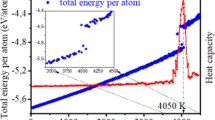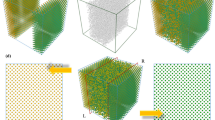Abstract
Formation of two-dimensional (2D) crystalline silicon carbide (SiC) from the melt is studied using molecular dynamics (MD) simulations. Model containing 11040 atoms interacted via the Vashishta interaction potential is cooled from 4500 to 300 K to investigate the change in structure and thermodynamic properties. We find evidence that crystallization of 2D SiC from the melt undergoes over some stages as follows. At temperature high enough, liquid 2D SiC exhibits the chain-like structure and further cooling leads to the formation of 2D SiC liquid with the ring-like structure. After that massive occurrence/growth of solid-like atoms occurs in the system leading to the formation of 2D SiC with a honeycomb structure. Moreover, out-of-plane displacements of atoms in the SiC nanoribbons at the selected temperatures are found and discussed.
Graphical abstract












Similar content being viewed by others
References
Glavin NR, Rao R, Varshney V, Bianco E, Apte A, Roy A, Ringe E, Ajayan PM (2020) Emerging applications of elemental 2D materials. Adv Mater 32:1904302
Seixas L (2020) Janus two-dimensional materials based on group IV monochalcogenides. J Appl Phys 128:045115
Laturia AA, Van de Put ML, Vandenberghe WG (2020) Generation of empirical pseudopotentials for transport applications and their application to group IV materials. J Appl Phys 128:034306
Guo Q, Chen N, Qu L (2020) Two-dimensional materials of group-IVA boosting the development of energy storage and conversion. Carbon Energy 2:54
Novoselov K (2011) Nobel lecture: graphene: materials in the flatland. Rev Mod Phys 83:837
Novoselov K, Morozov S, Mohinddin T, Ponomarenko L, Elias D, Yang R, Barbolina I, Blake P, Booth T, Jiang D (2007) Electronic properties of graphene. Phys Stat Sol B 244:4106
Blake P, Hill E, Castro Neto A, Novoselov K, Jiang D, Yang R, Booth T, Geim A (2007) Making graphene visible. Appl Phys Lett 91:063124
Kostarelos K, Novoselov KS (2014) Graphene devices for life. Nat Nanotechnol 9:744
Lalmi B, Oughaddou H, Enriquez H, Kara A, Vizzini S, Ealet B, Aufray B (2010) Epitaxial growth of a silicene sheet. Appl Phys Lett 97:223109
Stpniak-Dybala A, Dyniec P, Kopciuszyski M, Zdyb R, Jałochowski M, Krawiec M (2019) Planar silicene: a new silicon allotrope epitaxially grown by segregation. Adv Funct Mater 29:1906053
Lin H, Qiu W, Liu J, Yu L, Gao S, Yao H, Chen Y, Shi J (2019) Silicene: wet-chemical exfoliation synthesis and biodegradable tumor nanomedicine. Adv Mater 31:1903013
Ouyang J, Feng C, Ji X, Li L, Gutti HK, Kim NY, Artzi D, Xie A, Kong N, Liu YN (2019) 2D monoelemental germanene quantum dots: synthesis as robust photothermal agents for photonic cancer nanomedicine. Angew Chem 131:13539
Liu L, Ji Y, Liu L (2019) First principles calculation of electronic, phonon and thermal properties of hydrogenated germanene. Bull Mater Sci 42:157
Kostoglou N, Polychronopoulou K, Rebholz C (2015) Thermal and chemical stability of hexagonal boron nitride (h-BN) nanoplatelets. Vacuum 112:42
Liu L, Feng Y, Shen Z (2003) Structural and electronic properties of h-BN. Phys Rev B 68:104102
Nguyen HT (2019) Graphene layer of hybrid graphene/hexagonal boron nitride model upon heating. Carbon Lett 29:521
Chen B, Zhang M, Li X, Dong Z, Jia Y, Li C (2020) Tribological properties of epoxy-based self-lubricating composite coating enhanced by 2D/2D h-BN/MoS2 hybrid. Prog Org Coat 147:105767
Wu D, Huang C (2020) Thermal conductivity study of SiC nanoparticle beds for thermal insulation applications. Phys E: Low-Dimens Syst Nanostruct 118:113970
Wasekar NP, Bathini L, Ramakrishna L, Rao DS, Padmanabham G (2020) Pulsed electrodeposition, mechanical properties and Wear mechanism in Ni-W/SiC nanocomposite coatings used for automotive applications. Appl Surf Sci 527:146896
Nawaz H, Niazi AU (2020) A compact proximity-fed 2.4 GHz monostatic antenna with wide-band SiC characteristics for in-band full duplex applications. Int J RF Microw Comput Aided Eng 30:e22087
Xing H, Zou B, Wang X, Hu Y, Huang C, Xue K (2020) Fabrication and characterization of SiC whiskers toughened Al2O3 paste for stereolithography 3D printing applications. J Alloys Comp 828:154347
Shi Z, Zhang Z, Kutana A, Yakobson BI (2015) Predicting two-dimensional silicon carbide monolayers. ACS Nano 9:9802
Freeman CL, Claeyssens F, Allan NL, Harding JH (2006) Graphitic nanofilms as precursors to wurtzite films: theory. Phys Rev Lett 96:066102
Hoat D, Naseri M, Hieu NN, Ponce-Pérez R, Rivas-Silva J, Cocoletzi GH (2020) Transition from indirect to direct band gap in SiC monolayer by chemical functionalization: a first principles study. Superlatt Microstruct 137:106320
Le Nguyen TM, Hoang VV, Nguyen HT (2020) Structural evolution of free-standing 2D silicon carbide upon heating. Eur Phys J D 74:1
Wu P, Zhu W, Dai B, Chao Y, Li C, Li H, Zhang M, Jiang W, Li H (2016) Copper nanoparticles advance electron mobility of graphene-like boron nitride for enhanced aerobic oxidative desulfurization. Chem Eng J 301:123
Robinson J, Weng X, Trumbull K, Cavalero R, Wetherington M, Frantz E, LaBella M, Hughes Z, Fanton M, Snyder D (2010) Nucleation of epitaxial graphene on SiC (0001). ACS Nano 4:153
Bao J, Norimatsu W, Iwata H, Matsuda K, Ito T, Kusunoki M (2016) Synthesis of freestanding graphene on SiC by a rapid-cooling technique. Phys Rev Lett 117:205501
Castelino R, Pham TT, Felten A, Sporken R (2019) Substrate temperature dependence of the crystalline quality for the synthesis of pure-phase MoTe2 on graphene/6H-SiC (0001) by molecular beam epitaxy. Nanotechnol 31:115702
Lü T-Y, Liao X-X, Wang H-Q, Zheng J-C (2012) Tuning the indirect–direct band gap transition of SiC, GeC and SnC monolayer in a graphene-like honeycomb structure by strain engineering: a quasiparticle GW study. J Mater Chem 22:10062
Bekaroglu E, Topsakal M, Cahangirov S, Ciraci S (2010) First-principles study of defects and adatoms in silicon carbide honeycomb structures. Phys Rev B 81:075433
Sun L, Li Y, Li Z, Li Q, Zhou Z, Chen Z, Yang J, Hou JG (2008) Electronic structures of SiC nanoribbons. J Chem Phys 129:174114
Lin S (2012) Light-emitting two-dimensional ultrathin silicon carbide. J Phys Chem C 116:3951
Tersoff J (1989) Modeling solid-state chemistry: interatomic potentials for multicomponent systems. Phys Rev B 39:5566
Erhart P, Albe K (2005) Analytical potential for atomistic simulations of silicon, carbon, and silicon carbide. Phys Rev B 71:35211
Vashishta P, Kalia RK, Nakano A, Rino JP (2007) Interaction potential for silicon carbide: a molecular dynamics study of elastic constants and vibrational density of states for crystalline and amorphous silicon carbide. J Appl Phys 101:103515
Stillinger FH, Weber TA (1985) Computer simulation of local order in condensed phases of silicon. Phys Rev B 31:5262–5271
Le Roux S, Petkov V (2010) ISAACS-interactive structure analysis of amorphous and crystalline systems. J Appl Crystallogr 43:181–185
Humphrey W, Dalke A, Schulten K (1996) VMD: visual molecular dynamics. J Mol Graph 14:33–38
Scace RI, Slack GA (1960) Silicon carbide—A high temperature semiconductor. In: O’Connor JR, Smiltens J (eds) Silicon carbide - a high temperature semiconductor. Pergamon, Oxford, p 24
Harrison WA (1980) Electronic structure and the properties of solids: the physics of the chemical bond. Freeman, San Francisco
Hoang VV (2014) “Graphenization” of 2D simple monatomic liquids. J Phys: Condens Matter 26:205101
Mermin ND, Wagner H (1966) Absence of ferromagnetism or antiferromagnetism in one-or two-dimensional isotropic Heisenberg models. Phys Rev Lett 17:1133
Mermin ND (1968) Crystalline order in two dimensions. Phys Rev 176:250
Landau LD, Lifshitz EM (2013) Course of theoretical physics, vol 5. Elsevier
Bedanov V, Gadiyak G, Lozovik YE (1985) On a modified Lindemann-like criterion for 2D melting. Phys Lett A 109:289
Tewary VK (2009) Extending time scale in molecular dynamics simulations: Propogation of ripples in gaphene. Phys Rev B 80:161409 (R)
Smolyanistsky A (2014) Molecular dynamics simulation of thermal ripples in graphene. Nanotechnol 25:485701
Deng S, Berry V (2016) Wrinkled, rippled and crumpled graphene: an overview of formation mechanism, electronic properties, and applications. Mater Today 19:197
He YZ, Li H, Si PC, Li YF, Yu HQ, Zhang XQ, Ding F, Liew KM, Liu XF (2011) Dynamic ripples in single layer graphene. App Phys Lett 98:063101
Dewapriya MAN, Phani AS, Rajapakse RKND (2013) Influence of temperature and free edges on the mechanical properties of graphene. Modelling Simul Mater Sci Eng 21:065017
Hasik J, Tosatti E, Matonak R (2018) Quantum and classical ripples in graphene. Phys Rev B 97:140301(R)
Yu J, Katsnelson MI, Yuan S (2022) Distribution of ripples in graphene membrane. Phys Rev B 106:045418
Hoang VV, Giang NH, Dong TQ, Bubanja V (2022) Atomic structure and rippling in amorphous two-dimensional SiC nanoribbons. Comp Mater Sci 203:111123
Hoang VV (2022) Melting and pe-melting of two-dimensional crystalline SiC nanoribbons. Physica E 137:115012
Acknowledgements
We acknowledge Ho Chi Minh City University of Technology (HCMUT), VNU-HCM for supporting this study.
Funding
Ho Chi Minh City University of Technology (HCMUT), VNU-HCM.
Author information
Authors and Affiliations
Corresponding author
Ethics declarations
Conflict of interest
The authors have no conflicts of interest to declare. All co-authors have seen and agree with the contents of the manuscript and there is no financial interest to report.
Additional information
Publisher's note
Springer Nature remains neutral with regard to jurisdictional claims in published maps and institutional affiliations.
Rights and permissions
Springer Nature or its licensor (e.g. a society or other partner) holds exclusive rights to this article under a publishing agreement with the author(s) or other rightsholder(s); author self-archiving of the accepted manuscript version of this article is solely governed by the terms of such publishing agreement and applicable law.
About this article
Cite this article
Van Hoang, V., Le Nguyen, T.M. & Nguyen, H.T.T. Formation of 2D silicon-carbide nanoribbons by cooling from the melt and out-of-plane displacements of atoms. J Nanopart Res 25, 232 (2023). https://doi.org/10.1007/s11051-023-05883-3
Received:
Accepted:
Published:
DOI: https://doi.org/10.1007/s11051-023-05883-3




